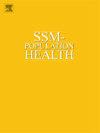Skin tone – a marker of bias known as colorism – in relation to sleep health among African American women
IF 3.1
2区 医学
Q1 PUBLIC, ENVIRONMENTAL & OCCUPATIONAL HEALTH
引用次数: 0
Abstract
People with darker-skin tone are more likely than their lighter-skin counterparts to have less access to health-promoting resources (e.g., economic security; quality housing; favorable neighborhood environment). These adverse conditions can affect sleep and result in poor health outcomes such as cardiovascular disease and depression. However, few studies have examined associations between skin tone and sleep disparities. To address this gap, we used cross-sectional (2010–2012) and longitudinal (until 2014–2018) data from the Study of Environment, Lifestyle and Fibroids cohort of 1674 Black women aged 23-35 years and residing in the Detroit, Michigan area. Skin tone was measured using a skin reflectance instrument and categorized as light [29.3–57.6] (25%), medium [57.7–72.4] (50%), and dark [72.5–106.1] (25%) brown. Self-reported sleep dimensions were dichotomized (yes vs. no): short sleep duration, non-restorative sleep, insomnia symptoms, and sleep apnea. Adjusting for age and educational attainment, we used Poisson regression with robust variance to estimate prevalence ratios (PRs) and 95% confidence intervals (CIs) and applied generalized estimating equations to log binomial models to determine risk ratios (RRs) and 95% CIs between skin tone and each sleep dimension, separately. Dark vs. light skin tone was associated with marginally higher prevalence and risk of short sleep (PR = 1.04 [95% CI:1.00–1.08]; RR = 1.07 [95% CI: 0.99–1.16]) and a lower prevalence of insomnia symptoms (PR = 0.95 [95% CI: 0.91–0.99]). Insomnia symptoms were more prevalent among women with light skin tone (21.1% vs. 17.7% [medium] and 15.6% [dark]). Our findings elucidate the critical importance and need to address the differential impact of historical ideologies, systems, policies, and practices on Black women, which can manifest health-damaging social phenomena like colorism.
肤色——一种被称为肤色歧视的偏见标志——与非裔美国女性的睡眠健康有关
肤色较深的人比肤色较浅的人更有可能难以获得促进健康的资源(例如,经济安全;质量住房;良好的邻里环境)。这些不利条件会影响睡眠,导致心血管疾病和抑郁症等不良健康结果。然而,很少有研究调查肤色和睡眠差异之间的关系。为了解决这一差距,我们使用了来自环境、生活方式和肌瘤研究的横断面(2010-2012年)和纵向(至2014-2018年)数据,这些数据来自1674名年龄在23-35岁、居住在密歇根州底特律地区的黑人女性。使用皮肤反射率仪测量肤色,并将肤色分为浅棕色[29.3-57.6](25%)、中棕色[57.7-72.4](50%)和深棕色[72.5-106.1](25%)。自我报告的睡眠维度分为两类(是与否):睡眠时间短、非恢复性睡眠、失眠症状和睡眠呼吸暂停。对年龄和受教育程度进行调整后,我们使用具有稳健方差的泊松回归来估计患病率比(pr)和95%置信区间(ci),并将广义估计方程应用于对数二项模型,分别确定肤色与每个睡眠维度之间的风险比(rr)和95% ci。深色肤色与浅色肤色相比,睡眠不足的患病率和风险略高(PR = 1.04 [95% CI: 1.00-1.08]);RR = 1.07 [95% CI: 0.99-1.16])和较低的失眠症状患病率(PR = 0.95 [95% CI: 0.91-0.99])。失眠症状在浅肤色女性中更为普遍(21.1%比17.7%[中等肤色]和15.6%[深肤色])。我们的研究结果阐明了解决历史意识形态、制度、政策和实践对黑人妇女的不同影响的重要性和必要性,这些影响可能表现为损害健康的社会现象,如肤色歧视。
本文章由计算机程序翻译,如有差异,请以英文原文为准。
求助全文
约1分钟内获得全文
求助全文
来源期刊

Ssm-Population Health
PUBLIC, ENVIRONMENTAL & OCCUPATIONAL HEALTH-
CiteScore
6.50
自引率
2.10%
发文量
298
审稿时长
101 days
期刊介绍:
SSM - Population Health. The new online only, open access, peer reviewed journal in all areas relating Social Science research to population health. SSM - Population Health shares the same Editors-in Chief and general approach to manuscripts as its sister journal, Social Science & Medicine. The journal takes a broad approach to the field especially welcoming interdisciplinary papers from across the Social Sciences and allied areas. SSM - Population Health offers an alternative outlet for work which might not be considered, or is classed as ''out of scope'' elsewhere, and prioritizes fast peer review and publication to the benefit of authors and readers. The journal welcomes all types of paper from traditional primary research articles, replication studies, short communications, methodological studies, instrument validation, opinion pieces, literature reviews, etc. SSM - Population Health also offers the opportunity to publish special issues or sections to reflect current interest and research in topical or developing areas. The journal fully supports authors wanting to present their research in an innovative fashion though the use of multimedia formats.
 求助内容:
求助内容: 应助结果提醒方式:
应助结果提醒方式:


